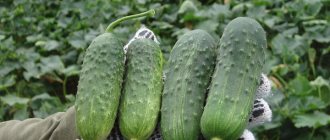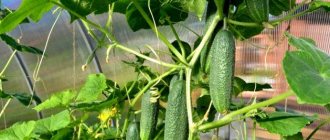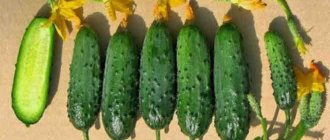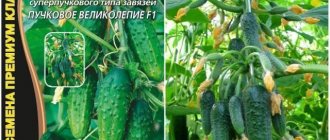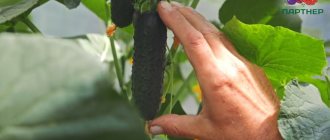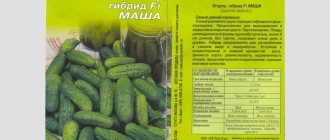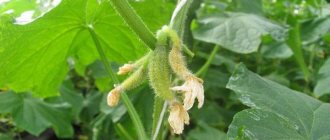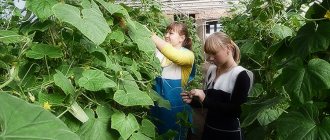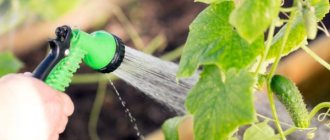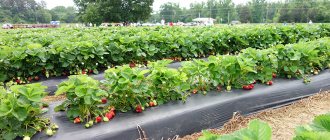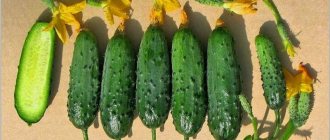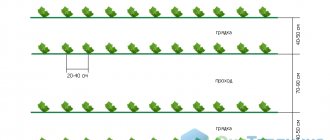The most productive varieties
For many farmers, the main indicator of the quality of a variety is the number of vegetables harvested per hectare (one hundred square meters), and not their taste or early maturity. The Russian selection options described below allow you to harvest up to 35 kg per square meter and are the most productive in the temperate climate zone. Let's look at the most prominent representatives of this group.
- Tumi cucumber. With proper care, one bush yields up to 10-12 kilograms; in some breeding areas it was possible to collect up to 39 kg per square meter. Unpretentious to moisture, not susceptible to brown spot, powdery mildew, anthracosis, and other known diseases. When tied to a trellis, it forms a solid “crown” that grows by 2-3 sq.m. and has good taste. It easily tolerates sudden changes in temperature, is well transported, and has increased shelf life. It can be grown in open ground, provided that good drainage is created in the soil and planted in loose soil. Medium late, technical ripeness of the fruit occurs in 45-53 days. The average length of the fruit is 9.5 centimeters and has a thin skin.
- Cucumber Sigurd. Excellent for planting in open ground, in greenhouse conditions. It is planted in late spring or summer. A strong root system provides resistance to white rot, gray rot, powdery mildew, melon aphids, and other diseases. Proper care and abundant fertilizer increase the yield up to 15 kilograms per bush. This type of vegetable will give even better results if you plant the bushes at a distance of one and a half meters. The plant quickly depletes the soil, so it requires large amounts of fertilizer. In addition to root fertilizers, you need to add foliar fertilizer mixtures. The fruits of this hybrid are characterized by a dark green skin color, the presence of pronounced tubercles, and high density. The size of the fruit varies from 9 to 13 centimeters.
- Cucumber Courage. It can rightfully be called the best version of the Dutch selection; it was bred in 1980, but after 7 years it became a “bestseller” in the Russian markets and actively acclimatized on our territory. Now Kurazh is considered a Russian hybrid, which confidently occupies the position of one of the highest-yielding greens - from one bush you can harvest up to 25 kg of vegetables , from one square meter up to 45 kg. Such indicators, of course, are only available with perfect care, but even in the hands of an ordinary summer resident, such a hybrid will fill the basement with delicious preserves and the table with fresh vegetables. Courage is resistant to Fusarium wilt and anthracosis of leaves, which very often affects even the best varieties of cucumbers for the greenhouse.
Despite the solid potential yield of the varieties described above, they can produce very weak yields if the plants are not provided with a large amount of moisture and organic fertilizers. If you are going to seriously engage in this business, you need to add compost and mullein in advance, since the bushes deplete the soil in a few months. The main indicator of “weakness” is slightly yellowed leaves - at this moment it is time to start applying nitrogen-containing fertilizers.
Secrets that will help increase your harvest
Experienced gardeners grow up to 25 kg from one bush and get more than one green harvest, but how do they do it? In fact, the secret lies in proper care of vegetables. To do this, you need to learn just a few rules:
- Add the roots to the vine. Impossible? It really couldn't be easier. When the stem appears from the ground and there are already 3 pairs of leaves on it, it is necessary to do hilling - cover the vine with soil up to the first leaf, maybe a little higher. Of course, fill it with water again. Additional roots will begin to appear on the vine, which increase absorption (moisture absorption) and provide vitality to the plant. It has been proven that such plants produce 40% more yield than without hilling!
- Loosening the soil. During the first 2 weeks of vine growth, it is necessary to loosen the top layer of soil so that more oxygen reaches the roots. Just don't overdo it - the roots are close to the surface and you may disturb them. It is necessary to loosen to no more than a depth of 5 cm. The vine will braid much better and grow longer. As a result, the harvest will increase by 11-13%.
- Pinching the stem. Have you ever pinched cucumbers? But in vain, since this is precisely the main secret that makes it possible to obtain record harvests. The technology for growing cucumbers does not provide for this procedure on an industrial scale, as it is very labor-intensive. But if you pinch the stem above the fifth leaf, a large number of side shoots will form, which will ultimately give you an excellent harvest of vegetables!
By following these simple recommendations, you can increase the number of cucumbers collected by more than one and a half times. For example, you can treat 2 bushes planted at the same time differently, and you will soon see how much caring for the vine can increase the number of cucumbers harvested!
The earliest ripening varieties and hybrids
Many winter varieties of cucumbers have a long ripening period (up to 70 days), which will not satisfy the requirements of many gardeners who want to get everything at once. It is known that in winter the price of vegetables is much higher and the profitability of vegetable growing increases significantly. The earlier you harvest, the more expensive it can be sold several months before the start of the season. If you are looking for early ripening cucumbers for greenhouses, the varieties in the list below will be the best option.
- Kibria cucumber. The earliest group, technical ripeness occurs in 45 days, due to which it is the No. 1 choice for many summer residents who grow vegetables in greenhouses. The generative power of the bush is very high, it forms a large number of fruits (up to 25 pieces), weighing 90-100 grams. In addition to being ultra-early, it has high yields. This hybrid brings up to 12 kg per square meter - an excellent result for domestic selection. Resistance to anthracosis and fusarium is high, and is most adapted for growing indoors. The taste is excellent, it has a characteristic crunch when biting, the flesh is sweet and very dense.
- Cucumber Meringue. An ultra-early ripening hybrid that tolerates low temperatures well (seeds germinate at +10 degrees) and reaches technical ripeness after 50 days. The average weight of one fruit is about 150 grams, quite large. Some specimens grow to 300 grams or more, but this is rare, since with proper care and timely harvesting, all youngsters have a marketable appearance. Resistance to rot is high, but often various types of fungi form on the leaves, including brown spots. It is recommended to treat with copper-containing preparations when growing crops indoors. The bushes are tall and very tangled; it is recommended to grow them on a trellis so that the bushes can be organized into the correct shape as best as possible.
- Cucumber Cupid. An ultra-early hybrid with a ripening period of only 42 days. The first green ones appear 35 days after germination; it is this feature that attracts many summer residents and farmers who want to grow vegetables in a greenhouse and are counting on an early harvest to make more profit. The average weight of one fruit is 80 grams, up to 35 pieces are formed on one bush, and an average of 12-14 kilograms can be collected from one square meter. As for disease resistance, it is high, primarily to anthracosis and verticillium wilt.
Ultra-early ripening species do not have high yields and even with ideal care in breeding plots they do not produce more than 15 kg per square meter. The taste also leaves much to be desired, since the rapid ripening of the fruit does not allow the accumulation of sugars and other substances that can affect the taste of the fruit. The only advantage of such a fast ripening period (relative to taste) is the crispy skin and pulp, for which they are valued by every consumer.
Documents and licenses
To run a cucumber growing business, you can choose one of several forms:
- Personal subsidiary farming. Such a business is exempt from paying many taxes; it is necessary to pay personal income tax on the sale of cucumbers. There are restrictions on the area of the farm - no more than 0.5 hectares, but it can be increased to 2.5 hectares. If you plan to hire employees, expand your product range, or organize a retail network for its sale, it is better to choose a different form.
- Individual entrepreneur. Removes restrictions on farm area and the possibility of hiring workers.
- Peasant farming. A full-fledged legal entity, suitable for organizing a business on a partnership basis. Tax benefits are also provided.
To carry out business activities in vegetable growing, VAT, income and property taxes do not need to be paid. You can choose Unified Agricultural Tax – a tax on net income of 6%. Agricultural activities are not subject to licensing. If you want to develop your business and cooperate with wholesale buyers, you must cooperate with sanitary control. Certificates and certificates for products are issued after checking cucumbers for the presence of prohibited chemicals. Also, supervisory authorities are required to check the growing conditions of products. If you plan to work with heated greenhouses, you will need a permit from the fire department. For private farming, this is not a mandatory requirement. For the other two forms of business, if there are expansion plans and work with wholesale customers, it is advisable to bring the greenhouse premises into compliance with the standards.
Varieties of Russian and foreign selection with the best taste qualities
For those for whom the number of vegetables collected, as well as their ripening period, does not matter, the following options will be the most suitable. They have the best taste, are the sweetest and crispiest. Suitable for salads, packing into jars, preparing vegetable dishes and simply for selling in bulk. They have an excellent presentation. We offer you cucumbers with the best taste and the highest content of vitamins.
- Cucumber Gunnar. An excellent option of Dutch selection, a hybrid whose taste has won the respect of many farmers and gardeners. Despite the fact that its yield is not too high (only 14 kg/1 sq.m.), the sugar content (5.3%) and a huge amount of ascorbic acid make it not only tasty, but also healthy for the body. The average length of green ones is 13 centimeters, and the ratio of length to diameter is 3.5:1. That is, it has an excellent presentation. Keeping quality and transportability are high, which is why it has become one of the most popular varieties for export. Technical ripeness occurs 60 days after germination (medium late). Acclimatized in temperate Russia, for the last 4 years it has been successfully grown in the Krasnodar breeding site.
- Claudia's cucumber. A representative of high-yielding and, at the same time, the most delicious cucumbers. It can produce up to 37 kg of sweet vegetables per square meter, all of which weigh no more than 85 grams. If you collect them in a timely manner, they are very elastic, and their flesh is dry and crispy. Resistance to diseases is good; only 1 treatment with fungicides is required during the growing season of the plant and it will last until the technical ripening of the fruit.
- Temp cucumber. A sweet, early ripening European hybrid, which has occupied a leading position in Russia for 11 years. It is planted not only by summer residents, but also by farmers who sell vegetables and export them over long distances. The keeping quality and transportability of the hybrid are very good, since the pulp is extremely dense and dry. When you bite into it there is never any bitterness, even in the skin, you can feel a sweet taste and crackle. Fruiting bunches of 3-4 vegetables are formed on the bush, each of which weighs 65-70 grams. There are no large fruits, the maximum weight is 85-90 grams, after which they turn yellow and lose their elasticity.
These varieties are an ideal option for anyone who grows vegetables “for themselves” and wants to get a good harvest of incredibly tasty greens. The ripening period is long, so early planting and heating are required to obtain fruits before the start of the season. Otherwise, ripening occurs already at the end of spring.
Useful tips for gardeners
Experienced vegetable growers advise:
- during active fruiting, collect fruits from cucumber vines daily so that the plant does not stop bearing fruit;
- as an additional feeding, use air feeding, carried out using a barrel filled with water and organic matter, which during the fermentation process release carbon dioxide and nitrogen into the greenhouse atmosphere, which are so beneficial for plants;
- stop watering for a short time, then resume it again, in order to use the stress received by the plant to encourage it to more actively produce female flowers rather than barren flowers;
- do not store cucumber fruits next to other vegetables and fruits, which, by releasing ethylene, force the overripening of cucumbers;
- Do not keep cucumbers for a long time in a warm place and in a brightly lit place before storing them, as this significantly worsens the consumer quality of the fruit.
The yield of cucumber crops directly depends on the plant variety and the place where it grows, and ultimately depends on human activity, which alone can put an end to the struggle for the harvest.
What gardener doesn’t want to get a good harvest from his plot? In order to increase the number of cucumbers grown indoors, you need not only good plant care, but also the right choice of crop variety. Recently, a lot of seeds have been sold in stores, and it is very difficult for a novice vegetable grower to decide. Let's look at the main high-yielding time-tested cucumber hybrids.
How to calculate the yield of cucumbers in a greenhouse and which variety is the most productive?
Every vegetable grower wants to get the richest and highest quality harvest - this is exactly what interests many farmers.
The most productive varieties: what to choose
It is necessary to understand that yield depends on many factors, where not only the arrangement of the greenhouse, but also the characteristics of the plant variety are of particular importance.
Depending on the variety, the vegetable grower can get early or late fruits, a rich harvest or unusually tasty cucumbers. Therefore, the selection of the appropriate type of seed will directly depend on the farmer’s priorities.
Hybrids
According to most gardeners, the most productive representatives of cucumber varieties are hybrids adapted to greenhouse conditions and resistant to most diseases and parasites.
The most productive varieties include:
- "Tumi": hardy, unpretentious to watering. Productivity: up to 12 kilograms per bush. Size of one fruit: up to 10 centimeters. Thin skin.
- "Courage": resistant to most diseases. Productivity: up to 25 kilograms per bush.
- "Amur": ultra-early and most productive hybrid. Productivity: from 30 to 50 kilograms per square meter.
- "Herman": super-yielding and self-pollinating hybrid. Versatile. Productivity: from 25 to 35 kilograms per square meter.
- "Prestige": early ripening hybrid. Hardy. Productivity: 25 kilograms per square meter.
- "Ekol": early ripening parthenocarpic hybrid. Ideal for pickling.
Self-pollinating
Conventional cucumber varieties, which require traditional external pollination with the help of insects, are mainly planted only in professionally equipped greenhouses equipped with special sliding ceiling panels.
As practice shows, the best self-pollinating varieties of cucumbers for greenhouses are:
- "Courage F1";
- "Heroic Strength F1";
- "Tournament F1";
- "Zozulya F1";
- "Sultan F1".
How to increase the yield of cucumbers in a greenhouse?
There can be many reasons for a decrease in cucumber yields, including:
- temperature too low or high;
- diseases;
- frost;
- excess or lack of moisture.
That is why it is necessary to carefully care for plants and create conditions favorable for their growth:
- create the correct temperature regime: from 18 (at night) to 30 degrees (during the day);
- ensure an optimal level of carbon dioxide: if sufficient concentration is provided (0.5%), productivity can increase by almost 50%;
- regularly ventilate the greenhouse in the evening, make sure there are no drafts;
- provide evening, daily and warm watering: about 5-10 liters of water per 1 square meter (in cool times - no more than 3 liters). When inflorescences appear, reduce watering to 4-5 liters.
- systematically feed the plants: immediately after planting and during flowering and formation of ovaries.
To obtain a rich harvest of cucumbers, experienced gardeners recommend after germination:
- Hill up the bushes only after the third leaf has formed;
- after the fifth leaf appears, pinch the shoot with a knife, as the formation of side shoots will help speed up the formation of fruits;
- regularly loosen the soil, trying not to harm the root system;
- cover the soil with compost or peat, which will allow the cucumbers to accumulate nutrients;
- artificially pollinate plants using a brush, transferring pollen from male inflorescences to female ones;
- Harvest in a timely manner, since regular collection of ripened fruits stimulates the ripening of new ones.
Tip: Once every two weeks, water the plants with milk diluted in water in a ratio of 1 to 2, this will additionally stimulate the growth of cucumbers.
Five days before the “smoking” procedure, it is necessary to stop watering.
Some secrets
In order to get a truly abundant and high-quality harvest, it is extremely important to follow all the rules at each stage of growing vegetables, because every seemingly little thing plays an important role in achieving the goal.
Therefore, many farmers advise:
- place the greenhouse on a flat place or with a minimal slope to the south, while groundwater should lie at a depth of 1.5-2 meters;
- install a greenhouse with a volume-to-area ratio of 2k1, which will allow maintaining ideal temperature conditions;
- build a bed no more than 25 centimeters high;
- stretch an elastic wire along all rows, to which you can later tie up grown plants;
- plant plants in such a way that there are no more than three plantings in one square space;
- It is necessary to start preparing the greenhouse in the fall: remove the remains of outdated plants and 4-5 centimeters of soil from the surface, since pathogenic organisms accumulate in this layer;
- pre-fertilize the soil;
- stabilize soil acidity levels;
- use high-quality soil;
- a few months before planting, treat all wooden elements of the greenhouse with a solution of copper sulfate, paint the iron parts;
- Before planting cucumbers, treat the soil with a hot solution of potassium permanganate.
How to determine yield?
Average
However, it is necessary to understand that to achieve this result, the farmer must:
- choose the right variety;
- choose the right soil composition;
- control the quality of purchased seeds;
- plant plants in a timely manner;
- ensure normal planting density;
- properly fertilize;
- maintain an optimal watering schedule;
- regulate the level of lighting in the greenhouse;
- observe the temperature regime;
- carry out prevention of possible diseases and damage to plants by pests;
- harvest in a timely manner.
In a year
With the right approach, a farmer can harvest cucumbers in a greenhouse throughout the year. But for this it is necessary not only to select the right plant varieties, but also to provide heating and lighting for the greenhouse to create favorable conditions necessary for growing cucumbers.
Per square meter
As practice shows, the average yield of cucumbers per square meter with normal care is about 30-40 kilograms, but if the plants are provided with additional comfort, the figure can increase to 50-60 kilograms.
From one bush
Thus, the most important rule in growing cucumbers is to observe moderation in everything. Maintaining optimal temperature conditions, regular ventilation and moderate air humidity will allow you to get a truly rich harvest that will be the envy of any neighbor.
Garter and shaping of cucumbers
Growing up, cucumber vines need support within a week after planting the seedlings in the greenhouse. At a height of 1.5-2 meters above the ridges, a wire is pulled, a twine is attached to it, which goes down to the plants.
At the bottom, the twine is wrapped between the lower leaves, this is obtained at a height of 10-15 cm, then as it grows, the cucumber lashes are already wrapped around the twine. In this vertical position, the cucumbers are better illuminated and ventilated, making them easier to care for and harvest.
Currently, trellis mesh made of polypropylene is on sale. You can simply pull it vertically along the growth of the vines, tie the cucumber bushes once, and then they will weave along them on their own.
You definitely need to engage in the formation of cucumbers (this means pinching the shoots and tying the main vine). At the bottom of the bush, up to the 5th leaf, all shoots are removed, on the next three side shoots with only one cucumber are left, then these shoots are pinched.
Above, on the next 3-4 shoots, 2 cucumbers are left and then these shoots are also pinched, 3 cucumbers are left in the upper part. Without pinching and gartering, the yield of cucumbers on the bush will be much smaller.
Cucumbers can be planted by stepsons, leaving the stepsons for germination and planting them as additional seedlings. But this must be done when the lower side shoots are removed when forming cucumbers. If the cut shoot is placed in water, after a few days it will produce roots, and such shoots can be planted in the ground.
Cucumber yield indicators in a greenhouse
You can grow vegetables and fruits in warm areas all year round. Sunlight will provide good yield per 1 sq. m and rapid growth of plants. But is it possible to get the same results for residents of countries with cold climates? Thanks to greenhouses, seedlings can be grown all year round. It will provide favorable conditions for plants and their rapid growth. However, no matter how equipped the room is, the result, first of all, depends on the efforts of the gardener. Cucumber harvest in a greenhouse - what stages does the growing process include and how can you achieve the most fruitful results?
Cucumber yield indicators in a greenhouse
Main risks
Competition is an important factor for small towns, whose residents grow cucumbers on their own in their dachas and garden plots. The demand for fresh vegetables increases only on holidays, and during the summer season the cost of cucumbers is quite low. The main risk for any business associated with growing vegetables and fruits is plant diseases and the risk of crop loss. Deep knowledge of agronomy, choosing the right site and disease-resistant varieties, purchasing high-quality equipment and fertilizers will help minimize these risks.
Arranging a garden bed
A greenhouse in the northern regions should be equipped with beds with an increased level of heat - manure or compost. They are usually set up in spring or early summer - in greenhouse or greenhouse conditions.
Manure beds
Manure beds are a good option. Cow is best, with horse as an alternative. Such natural fertilizing will provide the soil with the necessary nutrients. It is especially important to feed the developing fruit during the growing season.
The manure is laid out in a meter-long bed and covered with loose soil in a layer of 25 cm. This is followed by abundant watering. Seeds are planted at the rate of 3-4 plants per 1 sq. m. The advantage of this method is that there is no need to germinate or soak the seeds before planting. The seedlings can be covered with film to enhance the thermal effect.
Attention! Be careful with hot bed temperatures: maintain an average temperature of about 25 degrees, ventilate the area, and be careful not to burn yourself. The process is valid for one or one and a half months, so calculate the planting time correctly.
Compost beds
If there is no opportunity or desire to deal with manure, you can use organic material to fertilize warm beds with cucumbers: shavings, sawdust, dry leaves, etc. The landing principle is similar to the previous one. Only in this case, before planting, the seeds are germinated and placed in glasses or peat tablets.
Since the temperature will not be as high, this method is more relevant for farmers from warm regions. Northerners will have to wait for spring. Hot soil is a godsend for greenhouses, thanks to which cucumbers can be grown in greenhouses at any time of the year.
Review: which cucumbers are the most productive for greenhouses (video)
Each amateur gardener decides for himself which options will be comfortable for growing in a particular region. But central Russia is the most optimal for growing hybrids, which make it possible to obtain good yields of this type of vegetable.
- Author: admin
Rate this article:
- 5
- 4
- 3
- 2
- 1
(0 votes, average: 0 out of 5)
Share with your friends!
Transplanting
Greenhouse growing technology suggests that seeds must be hardened before planting and have at least 4 leaves - this directly affects the yield. Cucumber seedlings are planted in winter greenhouses in late January and early February. In spring, with a heating system - in early April, in a partially unheated system - at the end of the month or even in early May (depending on the availability of biofuel).
For the purpose of better air circulation and heating, planting is done on ridges 125 by 35 cm. Irrigation is carried out beforehand. The top of the planting cube should rise above the beds.
How many cucumbers can be harvested on average per 1 m²?
In order to talk substantively about the yield of a cucumber crop per 1 m², you should immediately decide on the place where it grows. This is due to the fact that in greenhouses the yield of cucumbers is on average 4 times higher than in open ground.
In addition, the yield of cucumbers in greenhouses, in turn, is influenced by many factors such as:
- correct choice of cucumber variety;
- proper soil preparation;
- quality of the seed used;
- optimal planting without thickening it;
- correct watering;
- sufficiency of lighting;
- correct choice of temperature;
- timeliness and sufficiency of fertilizing;
- prevention of diseases and pest invasions;
- timely harvesting.
First on this list is choosing the right cucumber variety. It is the varietal qualities that dramatically influence the yield of a given crop. Therefore, its average indicators in greenhouses range between 25 and 50 kg per 1 m². In open ground, these figures range from 8 to 12 kg per 1 m².
Tying cucumbers and care
Roots need air supply
Many gardeners underestimate the importance of this stage in the process of plant formation. Timely garter will save the cultivated crop from reducing the size of the leaves and, as a result, reducing the intensity of the harvest. The point is to lower the trellis loops while constantly watering the plant during its growth. The trellis is tied to a wire structure stretched along a row for 1 m.
The formation of the first bush starts after the appearance of at least 8 leaves, which is required for complete readiness. At the nodes below, 3-4 branches are plucked off. In the upper ones - one leaf and one fruit. When the plant reaches the very top of the wire, the main lash is wrapped around it twice, tied and pinched downwards, not reaching one meter to the ground.
Air supply and maintaining the required level of humidity are of great importance for the root system. Sometimes these things don't go well together. Therefore, the humidity in the greenhouse should be around 75% to meet both plant requirements. Particular care should be taken when watering in winter - only in the morning, in sunlight, using water at room temperature, no more than twice a week. If necessary, increase to three. Avoid getting liquid on the leaves of the bush.
Harvesting
You can start picking cucumbers 1.5-2 weeks after the start of flowering. They are collected regularly 2-3 times a week, as they will develop further, spending nutrients on this, and will not allow the rest of the ovaries to grow. Thus, the harvest will be smaller. The optimal size of cucumbers for picking is 10-15 cm long and 5 cm wide.
An interesting fact is noted by many cucumber lovers: the smaller the cucumbers, the tastier they are.
We can say that growing cucumbers is not easy, but if you follow all the growing recommendations, you can get a rich harvest of your crispy cucumbers!
Increased yield
So, on what factors does the fertility of cucumber seedlings depend? How to get a large number of copies:
- suitable variety;
- quality soil;
- timely disembarkation;
- correct planting density;
- abundant feeding and watering;
- good level of lighting in the greenhouse;
- set temperature mode;
- prevention of fungal diseases;
- protection from attack by insect pests;
- harvesting as it grows.
To increase the amount of fruit harvested per hundred, some farmers resort to nitrogen-containing fertilizers. The main thing here is not to overdo it - otherwise the cucumbers will become harmful for consumption. A safer option is to use air supply. A container with organic fertilizers diluted with water is installed in the middle of the greenhouse. Thus, nitrogen and oxygen are released into the indoor air. How many kg of cucumbers can be obtained from 1 m2 in a greenhouse? Experienced gardeners remove up to 30 kg.
One good and clever method, which was invented at the beginning of the last century, is to temporarily suspend watering. When it resumes, the plant, from the stress it has experienced, begins to form a large number of female flowers, almost without producing empty flowers.
Starting point: quality seeds
In the seed is the beginning of life. When planning cucumber plantings, the first thing you need to do is take care of high-quality seed material. It must be collected from strong, healthy plants and properly stored.
Pre-sowing treatment of seeds with growth regulators (for example, Epin Extra) increases germination and affects yield.
There are two ways to increase the future harvest of cucumbers:
- Start sowing seeds collected 2-3 years ago. All pumpkins, including cucumbers, have a peculiarity: long-term storage of seeds helps to increase the number of female flowers.
- Calibrate seeds before sowing. To do this, you need to dip them in a solution of table salt (3 g per 100 ml) and discard those that float. Only from a full-fledged seed will a strong plant grow.
- Warm up the seeds before sowing. In the old days, gardeners wore them in their bosoms from the end of winter, since it was noticed that plants with long vines but many “barren flowers” grow from “cold” seeds. Now you can place the bag closer to the battery a month before sowing.
What kind of cucumber crop can be harvested from 1 sq. m in a greenhouse?
What gardener doesn’t want to get a good harvest from his plot? In order to increase the number of cucumbers grown indoors, you need not only good plant care, but also the right choice of crop variety. Recently, a lot of seeds have been sold in stores, and it is very difficult for a novice vegetable grower to decide. Let's look at the main high-yielding time-tested cucumber hybrids.
Fertilizers and cucumber fertilizers
From 2010 to 2012, employees of the scientific laboratory of the Stavropol Agrarian University conducted a study on the effectiveness of a number of fertilizers for cucumbers. The drugs “Radifarm”, “Benefit” and “Megafol” were evaluated. All of them contain only organic components and are completely safe for plants. Compared to the control group, which was grown without fertilizing, the use of these drugs gave the following results:
| Growing option | Productivity, kg/m2 | Increase in control, kg/m2 |
| Without fertilizing | 22,1 | |
| Using “Radifarm” | 23,3 | 1,2 |
| Using “Benefit” | 23,5 | 2,4 |
| Using Megafol | 22,7 | 0,6 |
| Combination of three drugs | 26,0 | 3,7 |
The effect of fertilizing on yield is obvious. However, beginners in vegetable growing who have no experience in using fertilizers can use the safest possible option for feeding cucumbers - “herbal tea”. It is very easy to prepare. Any volumetric container is filled one third with cut grass. Everything is used - from the mowed lawn to the weeds. Of the latter, the best are nettle and dandelion.
You can also add a shovel of manure or a can of ash there. The mixture is filled to the top with water, the container is covered and left for ten days. When the mixture ferments and foams, it is used at a dilution of 1:10. “Herbal tea” not only feeds the plants, but also increases the cucumber’s immunity to diseases.
The most productive varieties of cucumbers for greenhouses
Often, when purchasing seeds, gardeners are guided by the yield that the manufacturer stated on the packaging. But you should understand that the number on the bag is conditional. The fact is that the agricultural company actually creates optimally favorable conditions for the growth and fruiting of the crop, which is not always possible to do on a summer cottage. Let's compare the yields of the most popular varieties:
| Name | Productivity from 1 m 2 kg | Productivity per hundred kg | Productivity per ha |
| Bochkova | 10,5 | 1050 | 1050 |
| Alligator | 9,4 | 940 | 940 |
| Timi | 11 | 1100 | 1100 |
| Friendly family | 10,3 | 1030 | 1030 |
| Amur | 30-50 | 3000-5000 | 3000-5000 |
| Prestige | 28 | 2800 | 2800 |
| Courage | 16 | 1600 | 1600 |
| Hermann | 25 | 2500 | 2500 |
| Northern lights | 29,3 | 2930 | 2930 |
As can be seen from the table above, the yield of different varieties varies greatly. This indicator directly depends on genetics, which determines the length of the main stem and additional lashes, and the number of female inflorescences in each node. The work of breeders in our time is aimed at breeding hybrids of the bunch type of flowering, therefore the yield of such hybrids is much higher than simple varieties.
What should you consider when growing vegetables?
It is recommended to start your business by calculating the costs and obtaining the likely benefits. It is necessary to take into account all the risks of the chosen business:
- the cost of seeds depends on the size of the plot where it is planned to organize the cultivation of vegetables. 1 hectare requires 70 thousand pieces of long-climbing cucumber varieties; bush plants can accommodate 150 thousand pieces. A thousand seeds cost about 1500-2000 rubles;
- an area of 6-10 acres can be processed manually. Over a larger area, mechanized plowing, harrowing, and sowing are required;
- By growing seedlings, you can ensure an earlier harvest of vegetables, which are more valuable at the beginning of the season. It is necessary to purchase fertilizers, a growth stimulator, and a transparent film to protect against night frosts. Agrofibre is more expensive, but it will last for several seasons;
- Cucumbers love not only warm weather, but also high humidity when growing. About 350 cubic meters of water are needed per 1 hectare, and the frequency of watering is at least 5 times per season;
- Marketing of grown products should be organized in advance. You can donate food to grocery stores, sell it yourself at the market, hire a salesperson, or provide self-pickup sales. The average cost of 1 kg of cucumbers at the height of the season is 30-50 rubles. You can get 15-20 tons of fresh vegetables per hectare per season. Freshly picked cucumbers can be stored for no more than 4 days;
- When setting up a retail space on the market, it is recommended to provide the goods with convenient storage, equipped to maintain a certain air temperature, ventilation, and product safety.
High-yielding greenhouse varieties of cucumbers resistant to diseases
To get a good harvest, it is not enough to plant high-yielding hybrids, since often common diseases and infections can reduce all attempts to get a lot of fruit to a minimum. Therefore, when choosing seed material, you need to pay attention to the resistance of the variety to common diseases. Let's look at the most popular ones:
Murashka F1
An early ripening variety that will delight you with cucumbers 45 days after sowing the seeds in the greenhouse. It is a parthenocarpic hybrid that does not require insects for pollination. The variety blooms in bunches, and as a result, high yield. The hybrid is resistant to many types of diseases. A fruit with good taste and universal.
Tom Thumb
An early ripening variety, the fruiting period begins on the 38th day, with a female type of flowering. The fruits are small, weighing no more than 60 g; this variety is ideal for any type of greenhouse and produces a consistent and good harvest. Resistant to diseases and viruses.
Benefit F1
An early ripening, self-pollinating hybrid, capable of producing a healthy harvest within 45 days. These versatile cucumbers have a very good taste without any natural bitterness. The advantage is that the plant practically does not suffer from diseases common to this crop.
Alekseich F1
An early-ripening crop with an average bush height. The hybrid is parthenocarpic, with independent pollination. Resistant to diseases, not susceptible to viral infections. It is characterized by high yield when grown indoors.
Emelya F1
Universal hybrid, early ripening, self-pollinating, heat-loving. It is worth noting that this variety has unlimited growth of the main stem, so it is necessary to form a bush to increase yield. Resistant to diseases. The hybrid yields its harvest in unison; during the active growing season, harvesting is carried out daily.
The Phoenix cucumber variety is considered a very promising variety, which is widely cultivated by gardeners. In this article you can find out what diseases the variety is resistant to and where this cucumber can be grown.
Selecting varieties for planting in a greenhouse
Not all varieties of cucumbers are suitable for growing in greenhouses, so you need to carefully study the packaging with seeds. Self-pollinating varieties are suitable for growing in a greenhouse.
Self-pollinating cucumbers do not need bees; pollination occurs without them. Such varieties do not have female and male flowers; one flower contains both stamens and pistil, and the pollination process occurs inside this one flower. For information, we list several self-pollinating varieties:
- early ripening hybrid "Benefis F1", resistant to diseases such as root rot and powdery mildew. Size 10-12 cm, suitable for blanks;
- early ripening hybrid “Emelya F1”, small cucumbers (8 cm) grow in bunches;
- parthenocarpic hybrid “Zyatek F1”, fruit size 10-16 cm, grows in bunches of 3-7 pieces, resistant to diseases and changes in weather conditions;
- parthenocarpic salad variety “Fed Papa F1”, cucumber size 12-15 cm, early ripening, resistant to root rot and powdery mildew, not suitable for pickling, but has excellent taste;
- variety “Claudia F1”, early ripening “Herman F1” and “Masha F1”, high-yielding shade-tolerant variety “Zozulya F1” and many others.
Parthenocarpic varieties can also be grown in a greenhouse. These cucumbers have only female flowers and therefore do not need pollination at all. The seeds in such cucumbers are very small.
It is important to distinguish between varieties and hybrids of cucumbers:
- You can take seeds from varietal cucumbers for next year and no longer buy the variety you like again. The properties of the seeds will not change over time.
- Seeds from hybrids (marked F1) do not convey their properties. And if next year it may still be possible to grow similar cucumbers from seeds collected from such a plant, then the next year the properties of the cucumber will be completely different. Therefore, you will have to buy new hybrid seeds every year. Of course, this is expensive, and hybrids are more expensive, but such cucumbers have a number of advantages. They have good yields, are shade-tolerant, resistant to low air temperatures, and are less susceptible to various diseases.
How to increase the yield of cucumbers in a greenhouse
So, how to get a large harvest of cucumbers in a greenhouse? To harvest a good harvest of cucumbers from a greenhouse, you need to follow certain rules for caring for the plant - timely pruning, watering and fertilizing.
The bush is formed as follows:
- Parthenocarpic varieties are formed into one lash, removing not only shoots, but also flowers up to the fourth true leaf. Then, layering is formed in four sinuses up to the first ovary, and pinching is performed. In the next 4 internodes, layering is formed up to the second ovary. And then the layering is pinched after the third ovary.
- Bee-pollinated cucumber species are formed into several layerings, since the main harvest can only be harvested from additional vines. To do this, after the sixth true leaf, the top of the plant is cut off. After this, they begin to form a bush from side lashes, avoiding thickening.
Fertilizing is another important factor that greatly affects the yield of crops in greenhouses. Usually three feedings are carried out over the summer, but when growing hybrids with a long growing season, at least 4 of them will be required:
- 14 days after planting in the greenhouse;
- as soon as the lashes begin to gain color;
- at the moment of formation of greens;
- during the main fruiting period.
It is worth noting that mulching the soil will help increase the yield of cucumbers in a greenhouse. Mulch helps retain moisture, prevents the growth of weeds, and provides additional nutrition for plants.
The plant itself will tell you what fertilizer it needs at the moment. If the following symptoms appear:
- little formation of lashes, the plant grows very slowly;
- on the main stem the lower leaves turn yellow and fall off;
- there are few flowers and ovaries, and the formed cucumbers are small and not juicy.
Your crop is signaling a nitrogen deficiency. And also you should pay attention:
- The leaves turn red or acquire a bluish tint, this indicates that it is time to apply phosphorus-containing fertilizers.
- The leaves have darkened greatly and a yellow border has appeared. At the same time, the fruits are watery and bitter, and the side shoots are strongly elongated without forming ovaries; it’s time to add potassium to the soil.
- Calcium deficiency can be identified by the unsightly and sometimes ugly shape of the fruit.
If you carefully observe the crop planted in the greenhouse, you will be able to immediately understand what to feed the cucumbers at the moment.
Cucumbers are moisture-loving plants. Watering should be carried out in a timely manner, the soil should not dry out, but waterlogging is also detrimental to the plant. The most optimal method of watering for cucumbers is drip irrigation and sprinkling. The water must be heated in the sun, otherwise root rot will appear.
To increase productivity, many gardeners water cucumbers at the root with milk. To do this, add 2 liters of milk to 10 liters of heated water. Such watering promotes good flowering and fruit formation.
Planting cucumbers in open ground and its features
First of all, you need to decide what row spacing you will have. They can be made small, about 50 cm, but then a mandatory garter and careful care of the vine are required. It is worth considering that the vegetative growth of the vine is quite fast and in just a few weeks it can grow to 5 or more meters. It is best to plant at a distance of 80-90 centimeters between rows.
The planting process is quite simple and there is no need to invent anything extra - just dig a shallow trench (10-14 cm) and put the seeds there. Fill the trench and water it abundantly so that the soil is saturated with moisture and the seeds can germinate easily. You can also apply fertilizers, but their effectiveness is extremely questionable at the stage of seed germination. It is best to use foliar fertilizers before flowering or apply compost in advance. But this must be done at least 5-6 months before planting, since cucumbers can simply burn from a high concentration of fertilizers.
Joint sowing is encouraged. Moreover, it will be very useful for the vegetable, especially if corn is adjacent to it. Let's take a closer look at all the advantages of this planting method:
- Corn will protect the cucumbers from the wind and sun, which will immediately affect their productivity and development speed.
- It will serve as a kind of support and the cucumbers can curl along it. This will make caring for them much easier.
- The shade will retain moisture and the earth will not crack.
It is worth considering that the row spacing of corn must be made very wide so that it does not interfere with harvesting, otherwise 30-40 days after sowing you will no longer be able to reach either the first crop or the second. The optimal row spacing is 150 cm. In this case, the row of cucumber should go almost along the row of corn, so that the entire row spacing remains for weaving the stem and for the passage of a person.
Video
You can also watch a video where an agronomist will tell you how to determine the number of cucumber fruits from one bush.
As you can see, the yield of cucumbers depends not only on good care. But if you are just starting out in vegetable growing, it is useful to understand that you need to buy good seeds and properly prepare them for planting. Sow the planting material in fertile soil and monitor the growth and development of the plant.
It is worth noting that if you do not stay on the site and collect greens every day during abundant fruiting, you will not see high yields.
How to grow cucumbers correctly
Even with a well-chosen cucumber variety, the final result still largely depends on proper cultivation of the crop.
Strengthening the root system
Cucumber plants have a rather weak root system, which is easily damaged when loosening the soil, and when the soil temperature drops to +13°C it can even die. There are several ways to increase the root system of cucumbers and strengthen it.
With the first method you need:
- Fill the containers in which the cucumber seeds are planted halfway with the substrate.
- Cover the containers with glass or film and place in a warm place.
- When the seedlings peck, after about 4 days, the covering is removed from the containers, and they themselves are placed on the windowsill.
- As the seedlings grow, substrate is added to the container until it fills it completely.
Productivity of cucumbers per 1 sq. m in a greenhouse
The climatic conditions of some regions and unfavorable environmental background negatively affect the development of cucumbers. As a result of the influence of external factors, there is low seed germination, a shortening of the fruiting period, and a decrease in the taste of the fruit. For these reasons and to obtain an early harvest, gardeners grow the crop in greenhouse conditions. You can increase the yield of cucumbers per square meter by planting plants in a greenhouse.
Cucumber growing areas in Russia
Cucumbers today grow throughout Russia. Even on Valaam, monks successfully cultivate this crop in their own greenhouses. Thanks to the efforts of breeders, in the Moscow region or in Siberia you can get a harvest no worse than in Kuban. However, it is important to consider several nuances.
Hybrids and varieties are bred taking into account local climatic conditions. Therefore, when selecting seeds, you need to look at which growing zone the variety is recommended for. This information can be easily found on the Rosreestr website in the appropriate section. Some manufacturers place it on seed packages in the form of a number indicating the tolerance region:
| Growing area | Regions |
| I | Arkhangelsk region, Murmansk region, Karelia, Komi Republic |
| II | Kaliningrad, Vologda, Kostroma, Leningrad, Pskov, Novgorod, Yaroslavl, Tver regions |
| III | Moscow, Bryansk, Ivanovo, Vladimir, Smolensk, Kaluga, Ryazan regions |
| IV | Kirov, Nizhny Novgorod, Sverdlovsk regions, Perm region, Chuvashia, Udmurtia, Mari El |
| V | Kursk, Voronezh, Belgorod, Oryol, Lipetsk, Tambov regions |
| VI | Krasnodar and Stavropol Territories, Rostov Region, Crimea, Adygea, Dagestan, Kabardino-Balkaria, Ingushetia, North Ossetia-Alania, Chechen Republic |
| VII | Penza, Samara, Ulyanovsk regions, Mordovia and Tatarstan |
| VIII | Astrakhan, Saratov, Volgograd regions, Kalmykia |
| IX | Chelyabinsk, Kurgan, Orenburg regions, Bashkortostan |
| X | Altai, Kemerovo, Tomsk, Novosibirsk, Tyumen, Omsk regions |
| XI | Krasnoyarsk Territory, Irkutsk Region, Buryatia, Yakutia, Khakassia, Tyva, Transbaikal Territory |
| XII | Primorsky and Khabarovsk Territories, Magadan, Amur, Kamchatka and Sakhalin regions |
If you cannot find information about the regionalization of the variety you like, you can rely on early ripening. For the Moscow region and other regions of the central zone, varieties of early and medium ripening are suitable. Ultra-early varieties are suitable for northerners, while southerners can afford late-ripening varieties. Read also the article: → “Cucumber varieties for open ground: self-pollinating, for the Moscow region, for the middle zone.”
How much harvest can be harvested from 1 square meter when grown in beds
Greenhouse conditions for plants are the most acceptable: the desired temperature regime and a high degree of air humidity are created. Cucumbers react very positively to both factors, making it easy to harvest a good harvest. In addition, there are many advantages of this cultivation method:
- the ability to enrich the soil composition with nutrients or completely replace it;
- limit the access of precipitation to the garden bed;
- reduce the risk of plant infection;
- obtaining an early harvest and extending the fruiting period;
- control of irrigation (amount of liquid and its temperature);
- competent introduction of fertilizing.
You need to prepare the greenhouse for planting in the fall. The surfaces of the structure are washed and treated with lime mortar for disinfection. The soil is fertilized and covered with a thick layer of mulch. In the spring, after cleaning the soil and walls, the soil is enriched with organic matter (manure, humus).
Planting is done in rows to make it easier to tie the vines to the trellises. 3 bushes are planted per square meter. The interval between the rows is at least 50 cm, so that it is convenient to move along the beds.
Productivity largely depends on the selected variety and type of greenhouse. Among the most prolific varieties are the following varieties:
- Tumi - up to 11 kg per bush;
- Amur F1 – from 30 to 50 kg per m2;
- Herman F1 – up to 25 kg per m2;
- Prestige F1 – up to 28 kg per m2;
- Ecole F1 – up to 9 kg per bush.
Cucumber yield
Seedling care
The seedlings are watered with warm water, not often, as they dry out. After 2-3 true leaves appear, the seedlings are fed with mineral or organic fertilizer. And when 3-4 leaves appear on the plant, you can start planting the seedlings in the ground.
Seedlings are planted in a greenhouse from mid-May, at which time the ground must warm up to 14-18° C, otherwise the plant may die. On the ridges we make holes at a distance of at least 50 cm.
If fertilizers were not added to the soil immediately when digging the ground, then fertilizers are added to the hole to a depth of 10 cm, covered with earth. Then water the holes with hot water and plant seedlings there with a lump of earth, lightly compact the soil around the plant. If the seedlings were planted in peat tablets, then they are planted directly with them, carefully removing the top layer of non-woven material from the tablets. The first time the planted seedlings are watered after 2 days.
Correct ways to store fresh cucumbers
Growing a good harvest is half the battle. It is important to preserve it for fresh consumption and preservation. There are many proven and new technologies that can be adopted. How long cucumbers can be stored depends on the storage conditions.
Refrigerated storage conditions
To ensure that cucumbers retain their presentation and taste longer, it is recommended to use the refrigerator. Knowing some rules and techniques will allow you to enjoy the aroma and freshness of greens from 3 days to a month and achieve an increase in shelf life.
Vegetable tray
The fruits do not change their quality for about 3 days if they are placed in a vegetable tray. There is no need for special training.
In a plastic bag
The fruits remain edible for up to 10 days if they are placed in a plastic bag and covered with damp gauze. The packaging should be left open for air circulation.
In paper towels
If you wrap each green with a paper towel and place it in a plastic bag without closing it at the top, the shelf life increases to 2 weeks.
In a tray with water
Cucumbers will stay firm and fresh for up to 3-4 weeks when stored in a tray of water. To do this, 1-2 cm of liquid is drawn into the container. All fruits are placed vertically in it with their tails down. The tray itself fits into the vegetable compartment. The water needs to be changed every 2-3 days.
In egg white
You can extend the shelf life of cucumbers to 1 month using egg whites. To do this, you will need to prepare the fruits - wash and dry with a paper towel. While the vegetables are dried naturally, you need to separate the white from the yolk and beat it a little with a whisk. Then each cucumber needs to be soaked and dried on a wire rack. The resulting protein film prevents the evaporation of moisture, as a result of which the greens are stored for a long time (at least a month) in the vegetable tray of the refrigerator.
How to preserve cucumber at home
There are enough methods for storing cucumbers indoors.
In a cardboard box
The shortest delivery time (2-3 days) is provided by a cardboard box or wooden box. The harvested crop is carefully placed in containers and placed in a room with a temperature of at least 10-15°.
You can preserve the fruits a little longer by lowering the temperature to 6-8° – up to 10 days.
In damp cloth
Greens remain fresh for about a week if they are wrapped in a damp cloth and placed in a cool room with a temperature of 6-7°. Where it is important to prevent the fabric from drying out so as not to disturb the humidity regime.
Regardless of the method used, it is necessary to inspect vegetables every 3 days and remove damaged specimens.
Storing cucumbers indoors
Growing seedlings
In greenhouses for growing cucumbers, pre-grown seedlings (25 days old) are used, this gives an earlier harvest. You can plant cucumbers in a greenhouse and immediately with seeds, but the soil must be warmed to +18°C.
Seed preparation
Seeds for planting must be prepared in advance.
Then the treated seeds can be warmed up by placing them near heating devices with a temperature of 50°C for 2-3 hours or for a month with a temperature of 25-35°C, this will make the seeds germinate faster.
Next, the seeds are soaked in a small amount of water (slightly covering the seeds) with a growth stimulator (sodium humate, Epin, or others) for several hours. And then they are placed in a damp cloth for germination for 1-2 days in a warm place. It is better if the roots only hatch a little.
If the seeds are hybrids and are colored bright green, it means that they have already been processed and there is no need to do anything with such seeds, including heating and germinating.
Soil preparation
To sow seeds for seedlings, we take soil consisting of:
- 2 parts of turf land;
- 2 parts humus or compost;
- 1 part sand.
To disinfect the soil mixture, it is necessary to heat it in an oven at 170°C for 10-20 minutes, freeze it, or spill the soil with a solution of phytosporin (15 ml per 10 liters of water). To make the soil loose, you can add vermiculite and fertilizers (ash 200 g, superphosphate 30 g).
Sowing seeds
This is done a month before planting in the greenhouse, approximately from the beginning of April. Each seed or two is planted in separate cups (you can take peat pots or tablets). Fill 2/3 of it with prepared soil, spill it with a hot, weak solution of potassium permanganate, make a small depression (1.5 cm) in it, put a cucumber seed and sprinkle with a thin layer of earth.
The top of the glass is covered with film and placed in a warm place (25-28°C). After 1-3 days, the film is removed and the seedlings are placed in a sunny place, perhaps on a windowsill, maintaining a daytime temperature of 20°C at night about 16°C.
Basic mistakes when storing crops
The home method of storing cucumbers has its own nuances. They came up with all kinds of ways to increase the shelf life of cucumbers, while making the most serious mistakes. Among the most incorrect pieces of advice, the following stand out.
- Packing the fruits in cellophane where there is no air access to the cucumbers. With such storage, a microenvironment quickly forms, which leads to the spread of rot.
- Filling a vegetable tray or container with cucumbers and other fresh fruits and vegetables that emit ethylene. The substance provokes biochemical processes that accelerate the overripening of greens.
- You cannot leave containers with cucumbers in a lit room. Under the influence of ultraviolet radiation, the skin changes color and yellowness appears.
- Fruits should only be placed in boxes or boxes when they are dry. If the harvest took place during the rain, then you need to give it time to dry. Wet cucumbers quickly wither and rot.
- Before preparing the fruits for storage, they are kept for several days at room temperature. This is a mistake; the picked fruits should be prepared as quickly as possible and sent to the refrigerator or cellar.
Proper storage of cucumbers
Building a greenhouse is not at all difficult, since the choice of materials allows you to choose the optimal design option. For residents of regions with harsh climates, growing any crop is quite problematic, but greenhouse conditions allow them to replenish their diet with fresh vegetables for 4-6 months. Proper storage will extend the period of replenishment of the body with vitamins and minerals, which cucumber is rich in.
Marketing
It is necessary to choose the form of taxation: a legal entity or an individual whose financial investments are significantly different. If the area under cucumbers is less than a hectare, it makes no sense to register a law firm.
It is required to study the product market:
- determine the fullness of the market with cucumbers in terms of each resident of the region;
- find out the purchasing power of the population, what category of people the product is intended for;
- find out everything about competitors in order to attract your regular customers by offering them the missing services;
- decide how to advertise your products.
To organize a business growing cucumbers and make a profit, you need to constantly improve your knowledge and practical experience.
Only competent management of agricultural business will lead to financial success. Share:
About digging a bed for cucumbers. What and why?
Cucumbers do not grow well in dense soil, so it is necessary to provide their roots with a supply of air. You need to dig up a bed for cucumbers 2 times on wet soil. If the soil is dry, you can water it lightly.
First, remove the fertile edge from the outer row to the depth of a spade bayonet, set it aside on the edge of the bed, then use a pitchfork to loosen the exposed bottom layer and moisten it a little.
After this, dig the next row, placing the fertile soil from it on the loosened, moist layer of the first row. Loosen the exposed bottom again with a pitchfork and moisten it. Thus, proceed until the end of the bed.
Cover the bottom layer of the last row with the top layer of the first row. With this digging, the cucumber roots will acquire a double supply of air.
